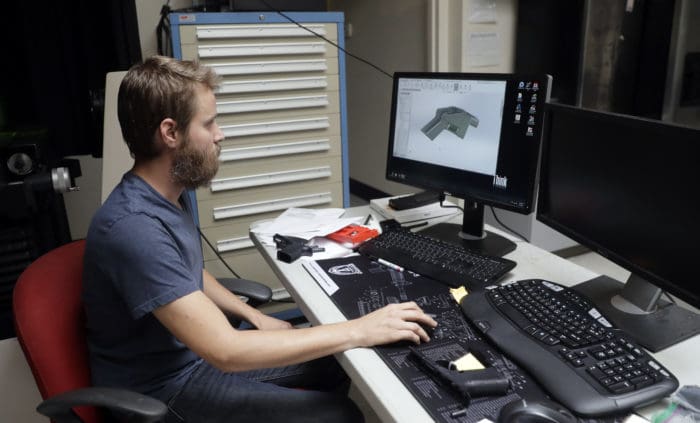By Larry Keane
After a decade-long effort led by NSSF, the transfer of export licensing of sporting and commercial firearm and ammunition products to the Commerce Department from the State Department is now completed. The “Export Control Reform” (ECR) initiative, as it is known, benefits not just major manufacturers. The long-sought reforms are a win for gun owners and hobbyists as well. For example, annual State Department registration fees for gunsmiths who don’t manufacturer firearms and never exported firearms are eliminated, saving small business owners $2,250 each year.
Twenty-three state attorneys general, made of up some of the most ardent gun control supporters, filed a federal lawsuit to stop the Trump Administration from completing the ECR initiative. They asked a federal judge to enjoin the final ECR rules from going into effect. They seized on the issue of 3D printing as a red herring. The National Shooting Sports Foundation (NSSF) intervened in the case and won, a victory for the industry and the customers it services, both domestically and overseas.
Yet, Carl Bussjaeger of wrote in The Truth About Guns, the NSSF as the industry’s trade association was throwing gun owners under the bus. His contention is NSSF didn’t fall on the sword and throw out more than a decade’s worth of work to expand markets for U.S.-based manufacturers. Bussjaeger offered half-hearted explanations of what the reforms do, what the case is about and what’s ahead.
TTAG readers deserve better, so here’s the truth.
They Fought Against All Guns
NSSF intervened in the case to keep 23 activist and gun control-loving state attorneys general from derailing export reforms that were begun more than a decade ago. The Obama administration started the reforms for our industry’s products, but purposefully left them unfinished for obvious political reasons.
The Trump administration worked diligently to move forward with completing the ECR rules for our industry. They were challenged at every turn, including last-minute red-herring arguments by U.S. Sen. Bob Menendez (D-N.J.) that rules to transfer export licensing and control to the Commerce Department would allow overseas unfettered access to 3D printing data files. On January 23rd, the Trump Administration pressed forward and published the final rules which were set to go into effect on March 9th.
The 23 states attorneys general immediately filed suit in federal court seeking to have the court block the Trump Administration’s final ECR rules from taking effect in their entirety. They seized on the same misinformed arguments concerning 3D printing to stop the ECR in its entirety. The Brady Center was quick to file an amicus brief supporting the state attorneys general effort. The NSSF alone intervened in the case to ensure that the long sought-after ECR rules would not be stopped.
We simply argued that, if the state attorneys general were entitled at this point in the case to a preliminary injunction, it should be limited to just the unresolved issues surrounding 3D printing technology and that the final ECR rules – representing 99% of the rules – should be permitted to go into effect. We succeeded. The antigun state attorney’s generals lost. Sorry, I’m not sorry.
Strong Industry, Stronger Rights
Today, U.S.-based manufacturers are more evenly matched against their overseas competitors. Senators who lead the gun control charge on Capitol Hill can no longer hold up contracts that exceed $1 million just because they don’t like guns. Gunsmiths no longer must pay a punitive $2,250 annual fee just to be in business, even though they don’t make or export guns.
The winner is the factory worker. The firearms industry supports more than 311,000 jobs across the country, paying those workers an average of $50,400. The firearm and ammunition industry make a $52 billion economic impact, paying local, state and federal taxes. The industry pays the Pittman-Robertson excise tax, more than $12.5 billion since 1937.
The effect of this effort is the industry can grow. Some estimates put that potential as high as 20 percent increase in export sales when U.S. manufacturers are now allowed to compete evenly in foreign markets.
The Technology for 3D Printing Firearms
The case is not over. The court only issued a preliminary injunction. It is important to understand that the case is now about whether the Administration properly issued the final ECR rules under the law.
The two federal statutes (Arms Export Control Act and Export Control Reform Act) that are the basis for the final ECR rules are intended to regulate the export of products and related technical data. Nothing in these statutes or final rules bars anyone from manufacturing a 3D printed firearm.
Domestically, 3D printing is legal and regulated by the Undetectable Firearms Act and state law in a handful of states. There are also important unresolved First Amendment issues that have yet to be litigated in this case. NSSF has consistently worked to dispel myths and falsehoods about 3D printing that spew from antigun politicians and gun control groups.
Bussjaeger should understand what Sen. Menendez knows and fears. A strong and competitive firearm and ammunition industry is good for American gun owners, American gun rights and American gun business.
Lawrence G. Keane is the Senior Vice President of Government Relations and Public Affairs and General Counsel for the National Shooting Sports Foundation, the firearm and ammunition trade association.
